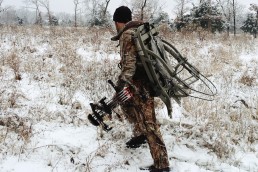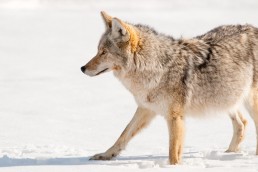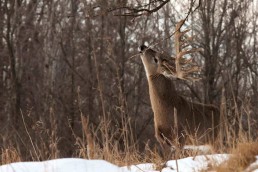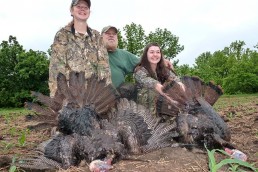Late-season Archery: Executing Your Shot
SHARE THIS POST
Late-season Archery: be ready to shoot despite bitter cold
Anyone who’s butchered a deer in the cold of late season knows how stiff and inflexible the muscles and tendons of a hanging deer become. We’re not much different. As our extremities cool, muscle fibers contract and blood shunts away from our arms and legs towards our body’s core. Both phenomena collude to create tightness in the upper body muscles used to draw the bow, decreased dexterity in our hands, and overall diminished strength. The end result? The very same bow you drew with ease in your backyard in August may be the bow that you struggle to pull back on in the stand in January. Follow these late-season archery tips to ensure you’re in shooting shape on a frigid sit when a deer walks by.
Start out warm
Clear your head and warm up those muscles by starting the day of your hunt with a warm shower. The water’s heat encourages blood flow to your extremities and loosens up those muscles and connective tissues. If time permits, stretch a little while you’re in there. Not only will you begin the day more flexible, but you’ll also mitigate the risk of injury by becoming more durable.
Stay warm
The benefits of a warm start can be undone if you allow yourself to get cold. Layer appropriately to stay warm as you travel to your stand and once you’re in and ready to hunt. It’s easier to remain warm than it is to warm back up after getting cold. Manage your thermodynamics to stay in that Goldilocks zone where you’re not too warm (you’ll sweat) or too cold (you’ll stiffen up) with various configurations of your zippers, gloves, hat and layers.
Stoke the furnace within by bringing calorie-dense snacks like nuts, cheeses, and granola. Digestion creates heat and a full belly is likely to keep you in the stand longer.
Stretch
Stretching while you’re in the stand physically lengthens muscles and connective fibers so they stay loose and ready for action. Think about the Tin Man from The Wizard of Oz. His stillness over time made his joints rusty and movement difficult. While I realize that movie wasn’t a documentary (or was it?), the concept holds true for the human machine. You must move, but not so much that you get busted by an approaching whitetail.
Here are a two simple stretches you can perform in the stand or blind:
Shoulder rolls – With your arms at your side, isolate your shoulders creating a circular motion. Start out rolling them forward, then backward.
Are you enjoying this post?
You can be among the first to get the latest info on where to go, what to use and how to use it!
Straight arm stretch – Straighten out one arm and bring it across your chest. Use the other arm to pull it in close to your body by wrapping that hand across the tricep of the straight arm and pulling inward toward the chest. Hold for five seconds and alternate arms.
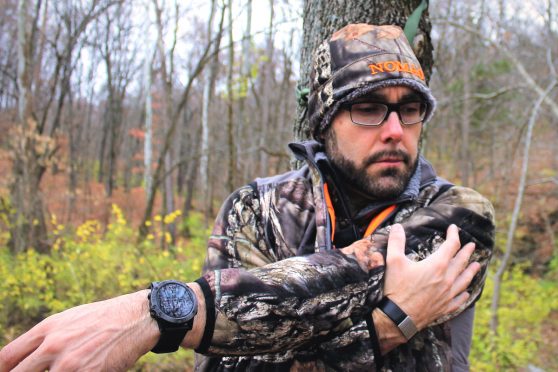
Draw
Stretching is important, but there is no movement that activates the muscles you’ll use for the draw like drawing itself. Once you’re settled in, draw your bow a couple of times to get loosened up. Depending on the temperature, on some frigid sits, I’ll draw every hour to keep ready and to give myself an idea of what the draw will look and feel like on that particular hunt. The colder you are, the more likely you’ll need a little body English to complete the draw cycle. This will inform your draw timing, because you’ll know approximately how much movement will be required when you eventually get an opportunity.

Practice in your gear
The bulkiness of winter hunting gear, on its own, increases the difficulty of your draw. You might even find an article of clothing that gets in the way of your shot. A sleeve that obstructs the bowstring’s path of travel or a collar that messes with your anchor point. Avoid finding out at the moment of truth that something is off with your shot sequence. Shoot in the exact clothing you intend to wear on the hunt. A thermal vest is a great way to enjoy the warmth of another layer while keeping your arms flexible.
As is the case with most of bowhunting, preparation is key. Late-season archery hunting provides the opportunity to pattern good deer in ways you can’t earlier in the year. But, you have the added challenge of what the cold does to your ability to shoot. Use these tips to stay warmed up and ready to draw when your late-season deer shows up.
If fishing and hunting were women, Tim would have married them both. Follow him on his mission to bring outdoor experiences the respect they are due and tune in to his podcast at TheThinkingWoodsman.com.
Got the bug for bowhunting? Consider a new challenge–bowhunting for fish!
MWO
SHARE THIS POST
Did you enjoy this post?
You can be among the first to get the latest info on where to go, what to use and how to use it!
Tim Kjellesvik
MidWest Outdoors works with more than 200 outdoor experts each year, who contribute articles based on their areas of expertise. MidWest Outdoors magazine offers more fishing and hunting articles than any other publication!
